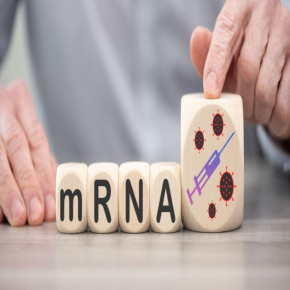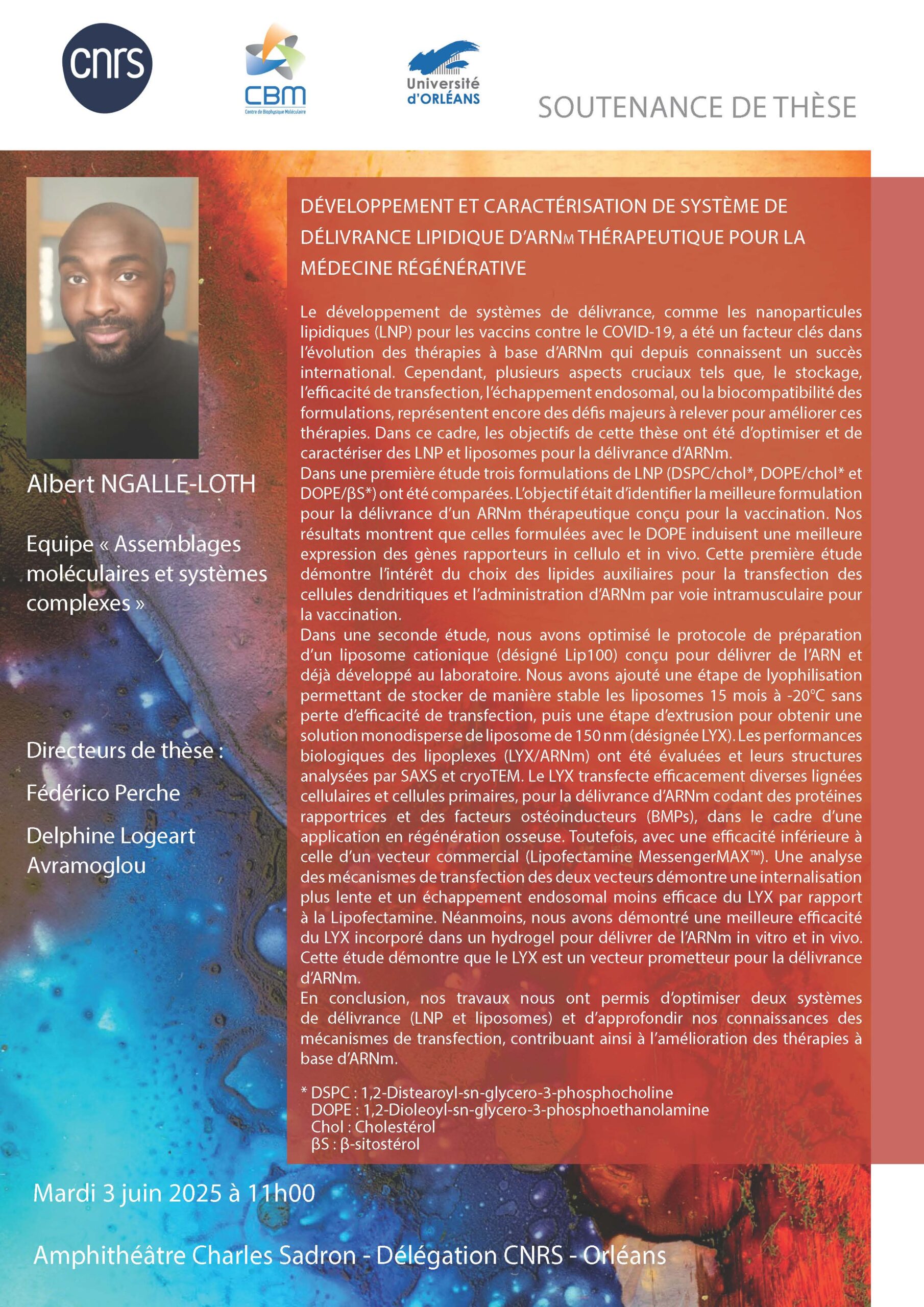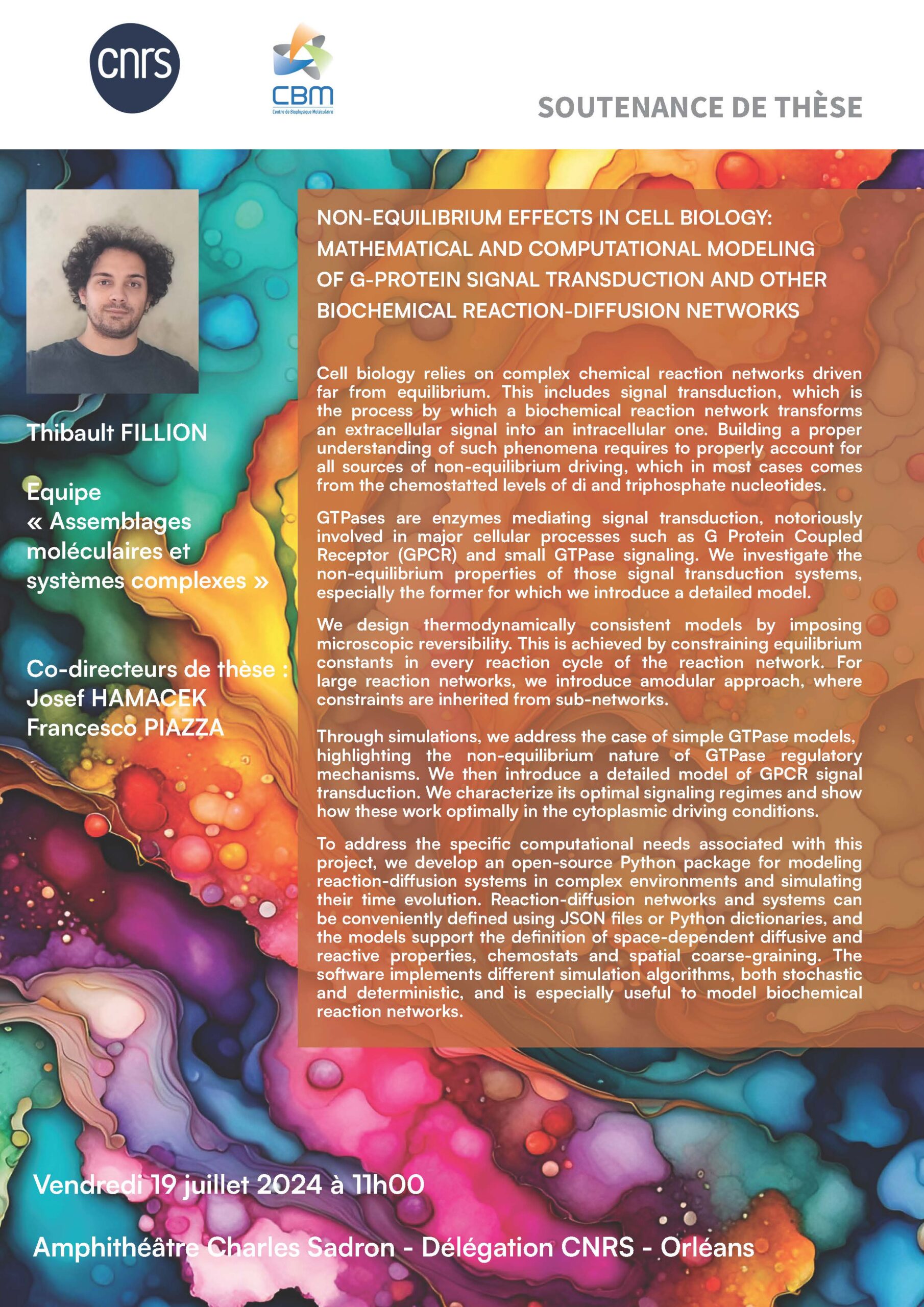Typologie d'actualités: Group Molecular assemblies and complex systems
Combination of nanomedicine and biophysics methods to characterize mRNA liposomes

This new optimised version of liposomes has been reported by CNRS Chimie on its website.
The development of lipid-based mRNA delivery systems has significantly advanced mRNA-based therapies. Liposomes, in particular histidylated liposomes (LYX), have been shown to be effective in delivering nucleic acids. In this study, LYX liposomes were optimised by adding a freeze-drying and extrusion step, resulting in improved homogeneity and storage stability. LYX liposomes maintained their size (150 ± 10 nm) and polydispersity index (0.10 ± 0.02) for up to a year at 4°C, while preserving their transfection efficiency. They exhibit a high mRNA encapsulation rate (∼95%) and protect it from degradation by RNases. The lamellar organisation was confirmed by small-angle X-ray scattering and CryoTEM. These liposomes allow efficient transfection of cell lines and primary cells, albeit with lower efficiency than commercial vectors, due to slower cell internalisation and reduced endosomal escape. They have demonstrated their ability to deliver mRNA encoding the therapeutic molecules BMP2 and BMP9, leading to the production of functional proteins capable of inducing BMP signalling. In vivo studies have also confirmed their potential for mRNA delivery when incorporated into hydrogels and implanted subcutaneously in mice. These results show that LYX liposomes are a promising and versatile platform for mRNA delivery in therapeutic applications.
This work involved laboratories from two institutes: the Centre de Biophysique Moléculaire (CNRS Chimie) and the Laboratoire de Biologie, Bioingénierie et Bioimagerie Ostéo-Articulaires (CNRS Ingénierie).
Reference:
Albert Ngalle Loth, Manon Maroquenne, Ayoub Medjmedj, Franck Coste, Thomas Bizien, Chantal Pichon, Delphine Logeart-Avramoglou, Federico Perche.
Structural and functional characterization of a histidylated liposome for mRNA deliveryStructural and functional characterization of a histidylated liposome for mRNA delivery.
Journal of Controlled Release (2025) Volume 379, pages 164-176, doi: 10.1016/j.jconrel.2025.01.010.
2 job offers open at CBM!

Welcome to Nikola Baslerova !

Doctoral student Nikola Baslerova is joining the “Molecular Assemblies and Complex Systems” team for a 3-month Erasmus stay, as part of a collaboration with the University of Pardubice in the Czech Republic.
Currently in her third year of doctoral studies, she carries out her research in the field of microbiology, but collaborates with chemists. The title of her thesis is “Determination of the biological activity of boranes and heteroboranes”.
At CBM, she studies the cytotoxicity of certain synthetic molecules, in particular complex, polyhedral boranes and heteroboranes. These compounds are of potential interest for certain biomedical applications, which are currently being explored.
July 19, 2024 – Thibault Fillion’s thesis defense

Protein filaments in the regulation of gene expression

Although every cell in our body contains the same genetic information, cells differ in the way they use it, a process known as “gene expression”. The regulation of gene expression is orchestrated by proteins called transcription factors, which bind to specific sequences within DNA. Transcription factors are traditionally thought to operate mainly as single molecules or dimers.
The article by Mance et al. reveals that several transcription factors of the family known as ZBTB, present in humans and other animals, have the capacity to form non-covalent filamentous structures composed of numerous identical copies of proteins arranged in a chain. At the molecular level, such structures could offer significant advantages for binding to DNA, which is itself an elongated molecule containing numerous repeated sequences. A few examples of filament-forming transcription factors had already been reported, but this study extends the concept to a large family of this protein with important functions. The study - which combines structural, biophysical and functional analysis carried out in vitro and in cells - was carried out by the "Post-translational modifications and DNA repair" team at the CBM and their collaborators in Orléans, Rennes and Marseille, including the "Functional mass spectrometry of molecular assemblies" team also at the CBM.
The findings from this research, together with a complementary study by groups of Benjamin Ebert and Eric Fischer from Dana-Farber Cancer Institute at Harvard (published back-to-back in the same issue of Molecular Cell), challenge the traditional view of transcription factor functionality.
In cells, ZBTB proteins are regulated through a process called SUMOylation, where a small tag called SUMO is added to them, changing how they function. Studies on ZBTB proteins undertaken in Orléans, during which the filamentous structures were discovered, are part of the "SUMOwriteNread" project funded by the European Union (ERC grant no 101078837). Researchers are currently investigating the interplay between the ability to form filaments and SUMO tagging to understand the complex reality of gene expression regulation.
This research was reported by CNRS Chimie on its website.
Dynamic BTB-domain filaments promote clustering of ZBTB proteins.
Lucija Mance, Nicolas Bigot, Edison Zhamungui Sánchez, Franck Coste, Natalia Martín-González, Siham Zentout, Marin Biliškov, Zofia Pukało, Aanchal Mishra, Catherine Chapuis, Ana-Andreea Arteni, Axelle Lateur, Stéphane Goffinont, Virginie Gaudon, Ibtissam Talhaoui, Ignacio Casuso, Martine Beaufour, Norbert Garnier, Franck Artzner, Martine Cadene, Sébastien Huet, Bertrand Castaing & Marcin Józef Suskiewicz
Molecular Cell 2024
https://doi.org/10.1016/j.molcel.2024.05.029
CNRS Chimie Emergence@International

Federico Perche, a researcher in the "MACS : Molecular Assemblies and Complex Systems" team, has been awarded CNRS Chimie Emergence@International.
He will be going to the United States to develop research collaborations in his field of mRNA and siRNA delivery.
During a 2-week stay, he will visit the Universities of San Diego (Pr Kwon and Pr Shresta, Arizona (Dr Liu), Texas A&M (Dr Zhu) and Chicago (Dr Voth).
Federico has started a collaboration with Dr Shresta on mRNA vaccination and is looking to develop new collaborations.



